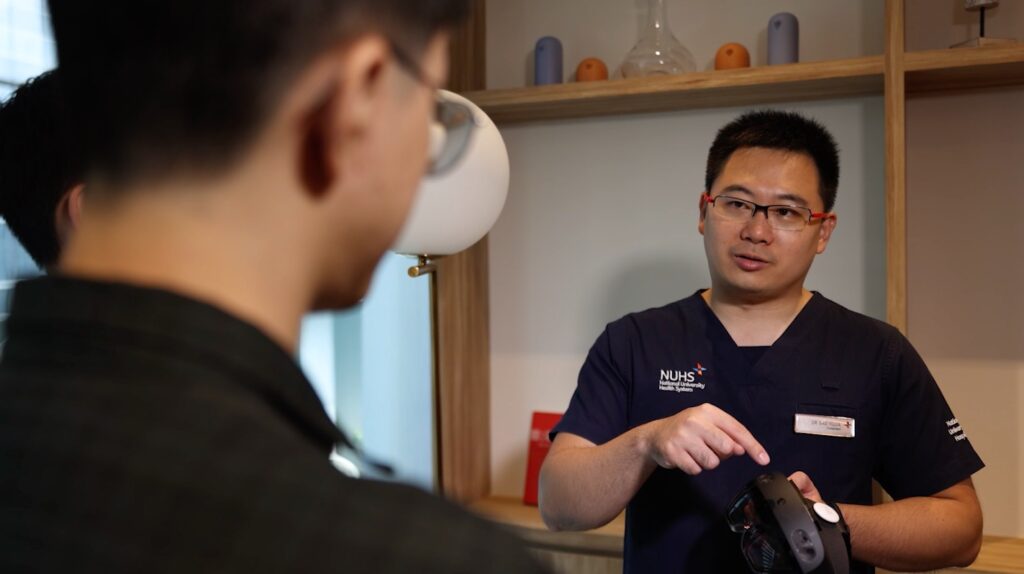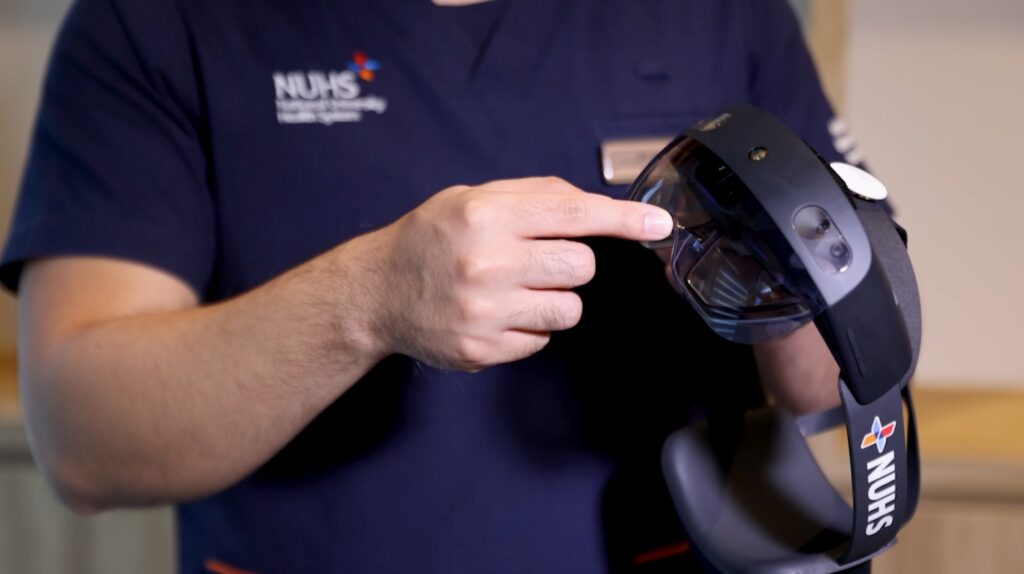From a childhood interest in gadgets to being a technology adoption pioneer in using early editions of Microsoft and Windows platforms when they first arrived in the market in the 1990s, technology has always been an integral part of Dr. Gao Yujia’s life, even before he found his lifelong passion for medicine and technology.
As a liver, pancreas, and liver transplant surgeon at the National University Hospital in Singapore, Dr. Gao’s career in medicine spans 12 years. During these years, Dr. Gao has seen an exponential increase in the use and integration of emerging technologies into medical practice. This process has led to tremendous changes in the way medical practitioners deliver healthcare to patients.
As a junior doctor, much of his day-to-day routine involved manual tasks, including updating patient charts and medication records and acknowledging patient results, and this even extended to viewing medical scans. Driven by the need to streamline processes for greater efficiency, less wastage, and above all, enhanced patient care, Dr. Gao started looking for innovative solutions to everyday challenges faced by healthcare professionals.
Making lives better for patients, doctors, and frontline healthcare workers
Dr. Gao’s journey to shaping new frontiers for healthcare with technology began in 2019, when Associate Professor Ngiam Kee Yuan, Group Chief Technology Officer, and Senior Consultant at the National University Health System (NUHS), roped Dr. Gao into a half-day workshop for the launch of the Microsoft HoloLens 2.
Having never used a Mixed Reality device prior to the workshop, Dr. Gao remembers vividly the moment when he put on the HoloLens 2 for the first time. Seeing the device’s ability to create highly precise 3D visualizations of real-world objects and allow users to interact with these holograms using simple gesture controls was an incredible and exciting experience for Dr. Gao because it opened up a whole new world of possibilities and applications in healthcare.
At that time, there were few use cases of the HoloLens 2 in healthcare as no other medical institutes were using it for direct patient care at scale. For the institutes and hospitals that used the technology, it was mostly confined to areas such as training, education, and small-scale trials.
Despite having no existing data and medical evidence to reference, Dr Gao and his team felt that this technology showed immense potential in transforming the delivery of healthcare services to benefit patients in the long term. After the workshop, Dr. Gao and his team began working with Microsoft and ApoQlar to trial the HoloLens 2 across various departments in the hospital in August 2020.
Three years on, Mixed Reality technology has proved to be more than a fad. With a Health Sciences Authority (HSA) Class A License and the Singapore Standard SS260 certification, this technology has been used by surgeons for planning and guiding over 100 cases in NUH and Ng Teng Fong General Hospital across eight to nine specializations such as neurosurgery, cardiac, liver transplant, endocrine and facial reconstruction surgeries.
Apart from surgical planning, the technology has the potential to evolve how healthcare workers can deliver clinical diagnoses faster and most efficiently. In one example, doctors at NUHS perform thousands of scans each year, with nearly 80% of thyroid ultrasound scans done for regular surveillance to monitor and detect the presence of certain diseases such as thyroid nodules and cancers. Using Mixed Reality technology, this process may be shortened significantly from weeks to almost minutes, allowing doctors to diagnose injuries or illnesses and update patients in a significantly shorter period of time.
By integrating this technology into the field of healthcare, NUHS is moving the needle with the transformative power of Mixed Reality technology to empower healthcare providers with the right tools for swifter and more accurate decision-making and interventions.
From the patient’s perspective, reducing the waiting time for test results alleviates the anxiety and fear commonly experienced whilst awaiting medical diagnoses. Dr. Gao discovered that the Mixed Reality devices could also be used in patient counseling, as patients get to better understand their condition and surgical procedures that they will experience with the help of 3D visualization.
“Most of us are visual creatures, and we need to see something to understand it. That visual element plays a huge part in patient education, helping them understand and relieve a lot of anxiety during the buildup to a surgery,” says Dr. Gao.

NUHS first deployed Mixed Reality technology in patient counseling by using the HoloLens 2 to explain surgical procedures to patients who require brain surgery. By putting on the device, surgeons, patients, and their family members can easily view 3D holographic images of the patient’s MRI scans. Moreover, surgeons can link multiple devices to the technology to share and display the same 3D imaging, allowing them to explain the entire procedure to the patient in detail during patient counseling.
The ease of use helps patients and family members comprehend medical conditions and upcoming surgeries significantly better than trying to do the same on a computer screen, a piece of paper, or a generic model. Patients can use highly realistic visualizations from the HoloLens 2 to explore and understand their anatomy and see things from a surgeon’s perspective – this would never have been possible in the past.
Conversely, surgeons can provide more tailored recommendations and better inform patients of surgery risks when they can use the technology to understand the patient’s perspective. Doctors require years of education and training to interpret imaging test results accurately, and this means it is an uphill challenge for people with minimal or no medical knowledge to grasp what their test results actually mean. By using Mixed Reality devices, doctors can help simplify complex information such as scan images and surgical procedures for patients more effectively than drawings and generic models.
Bringing the healthcare industry into the future with innovation
Beyond leveraging the technology to support in training and education, Dr. Gao is confident that the use of Mixed Reality technologies can extend to clinical applications and directly impact patients. More than just an end-user of this technology, Dr. Gao has become a global advocate for the use of technology in the healthcare industry, and consistently urges his peers at the Holomedicine Association to explore the use of Mixed Reality in everyday work.
Over the past few years, Dr Gao. has engaged numerous hospitals, healthcare institutes, government bodies, investors, and industry partners on the potential and future of Mixed Reality technology in healthcare. He firmly believes that Mixed Reality is more than just a user device – they are a technological platform with enormous potential for further enhancements to evolve and revolutionize healthcare. Through his efforts and many like-minded individuals, the adoption of Mixed Reality technology in healthcare has increased tremendously over the last few years.
Inspired by the positive feedback and outcomes for patients and healthcare workers in NUHS since implementing the NUHS Holomedicine Program, Dr. Gao is optimistic that technologies like Mixed Reality and AI will be integrated deeper into the hospital operations with the advancement of 5G, as healthcare needs become increasingly complex.
For example, 5G technology and edge computing can provide critical scalability and flexibility to process massive volumes of data into usable clinical information. Healthcare workers on the move around the hospital premises with the HoloLens 2 can then use Mixed Reality devices without worrying about lag time or connectivity issues that affect the streaming of ultrasound images or videos.
Integrating the HoloLens 2 with 5G technology and edge computing capabilities is also critical to creating a unified data system for patient information shared by healthcare practitioners and facilities across the country.
As healthcare systems need to process tens to hundreds of thousands of data points per patient per day today, Dr. Gao envisions that this integrated technology will serve as critical support for an infrastructure allowing medical institutions across public and private sectors to access patient data from a single touchpoint.
In order to ensure that the technology integration becomes a reality, NUHS has deployed its dedicated indoor 5G integrated network, which will be used for the HoloLens 2 and many other medical capabilities that rely on the same purposes and secured data transfer.
A peek into our future
Having witnessed how his three-year-old daughter quickly and easily picked up the use of the HoloLens 2, Dr. Gao sees massive potential in the technology to unleash limitless possibilities, not just in healthcare, for future generations.
When Dr. Gao first placed the headset on his daughter, he wondered if her young eyes could perceive the intricate visuals and understand the augmented reality experience at her tender age. However, these doubts were quickly dispelled when she eagerly extended a hand upon sighting a hummingbird through the HoloLens 2, bidding it to come closer, proving that interacting with the virtual environment comes naturally to her.
Dr. Gao’s commitment to fostering technological growth and innovation in the healthcare industry extends to mentoring and guiding younger professionals like Dr. Zachery Yeo, Assistant Project Manager of Holomedicine Program at NUHS and Resident Physician at the Alexandra Hospital, and Ng Kian Wei, Data Scientist at NUHS. “The NUHS Holomedicine Program provides a platform for technologists to closely collaborate and build impactful solutions with clinicians, leveraging Mixed Reality to enhance the impact of recent cutting-edge AI developments,” says Kian Wei.
Driven by a vision where technology amplifies the impact doctors can have, Dr. Yeo has been championing the future of healthcare with technology alongside Dr. Gao to make impactful changes for patients. “Working with Dr. Gao provided me with a pivotal opportunity to further my objective of integrating the realms of technology and medicine. Under his guidance, I gained invaluable experience in developing various applications alongside Kian Wei. Additionally, garnering feedback from clinicians and implementing subsequent iterations within the hospital. It is a joy and privilege to work in the Holomedicine team,” says Dr. Yeo.
Inspired by the profound adaptability that seems to define the generation growing up in the digital era, Dr. Gao says, “Mixed Reality devices like the HoloLens 2 may be a novelty for us, but ten years down the road, these devices might become ubiquitous and using them could become the norm for the younger generations.
It is like how smartphones are the standard for the generation of digital natives – it is not a device that the previous generation grew up with. I am excited and proud to contribute to this process of advocating for and developing the use of new technologies, from cloud, to 5G, AI and Mixed Reality, as we bring together the best of technology to do good for the world.”.

